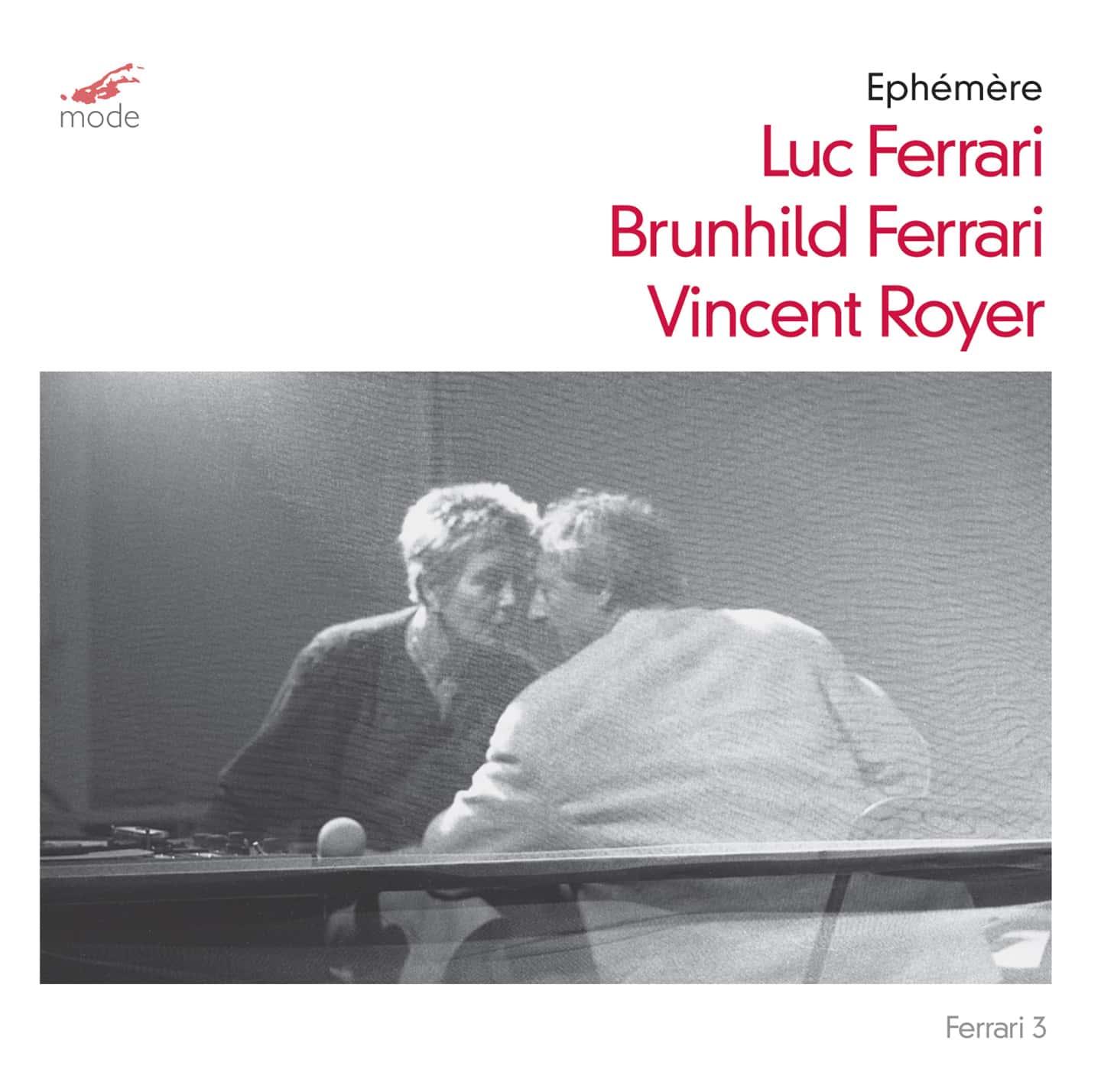Ferrari Edition 4
LUC FERRARI: Ephémère (1974) 13:08
new version for viola & tape by Brunhild Ferrari (2012)
Vincent Royer, viola
BRUNHILD FERRARI: Le Piano Englouti (2012) 18:03
version for viola & tape
Vincent Royer, viola
VINCENT ROYER – LUC FERRARI: Pour que le vent soit propice (2011) 40:23
based on “Ce qu’a vu le Cers” (1978) by Luc Ferrari
Vincent Royer, viola, voice, percussion & electronics
This album tells stories about wind, ocean and a village feast in the southern France… The listener is led into a poetic journey about freedom and impermanence.
It brings together three Ferrari-related works: by Ferrari himself, by Ferrari’s wife Brunhild Meyer-Ferrari and an improvisation by Royer to one of Ferrari’s soundscapes.
Luc Ferrari was very interested in collaboration. New music violist Vincent Royer began collaborating with Ferrari following their meeting in 2001.
Regarding Ephémère (1974), Ferrari wrote: “This musical piece – which, as its name says, is based on the effects of the sea – is intended for musicians open to all types of music. As the name says too, this tape has been conceived as a snap of time.” In 2012 Brunhild Ferrari realized this new version for Royer’s viola.
BRUNHILD FERRARI’s Le piano englouti (“The Sunken Piano”) is a tape piece comprised of recorded and processed sounds. The sounds were recorded over 14 years, at a Greek island almost swallowed by the noisy Aegean Sea, and in 2010, at a very discreet and silent Japanese island. Originally composed to accompany a piano, as in Debussy’s work of the same name, this version is arranged for Royer’s viola.
The ROYER/FERRARI Pour que le vent soit propice uses Ferrari’s tape piece Ce qu’a vu le Cers as the basis for a viola & electronics improvisation. This live recording captures the special mood of the intimate concert surroundings it was recorded at.
Liner notes by Brunhild Ferrari and Vincent Ro
Reviews
Royer is a restless musician. His earlier collaboration with Ferrari and pianist Jean-Philippe Collard-Nevin resulted in a powerful collection on Sub Rosa SR 261: Rencontres Fortuites (2003), Tautologos III (1969), and Didascalies (2004), not to mention Didascalies 2 (1993) on Sub Rosa SR 363-AB. (Yes, Didascalies 2 was written earlier; however, it was titled after the 2004 work came into being.) The fervor continues with a release in which Royer almost completely dissolves into Ferrari’s tapes.
Éphémère can be for tape alone, or for tape with instruments. Ironically, the performers’ activities are ephemeral, whereas the tape is fixed. Alga marghen Plana-F 33NMN.081 documents two renditions (I, Nov. 1974, and II, the same month a year later). For this instantiation, Brunhild updated the work for Royer. Brunhild and Royer’s version is shorter (13:08) than either of the two on Alga marghen (27:03 and 51:35), however the piece’s duration is inherently flexible (my understanding is that I is tape alone and II adds electronically processed instruments). We are to understand that the Éphémère’s tape is like the sea, that the work ought to imitate the ocean. There are subtle loops and murmuring voices over an insistent, engulfing electronic buzzing drone on the original tape.
Brunhild’s tape offers the essence of the content heard plainly in I. Royer is credited with just viola, although I think he also explores piano and percussion as well. His actions (delicate scratching on viola, interior piano sounds, bells) emerge out of the troughs in the cresting tape. Overall the progression is perkier and more compact than the mid-70s realizations. We quickly learn that Royer will rarely play the viola conventionally.
Debussy hovers at the fringe, as we see in the titles and sources of Brunhild and Royer’s pieces. Le Piano Englouti and Pour que le vent soit propice / Ce qu’a vu le Cers both reference piano preludes (Book I, No. 10 and Book I, No. 7). Brunhild takes a more oneiric direction than perhaps Luc ever would. Le Piano Englouti is episodic with contrasts and pauses, begging an adventure story. Royer’s fidgeting viola emerges over dreamy textures. I am immediately struck that Brunhild is creating a place that never was whereas Ferrari took real locations and transformed them.
The tape from Ce qu’a vu le Cers reflects nature, capturing sounds around Tuchan (a small town in France, also the kernel for a larger Luc and Brunhild multimedia work), birds, bells and insects with talking and crowd noises from a carnival. It’s meant to be a backdrop for an improvising ensemble, as in ADDA 581088, with the Le Vivant Quartet: Richard Breton, guitar, Jules Calmettes, flute and sax, Henry Fourès, piano, and Alain Joule, percussion. The older release (1988), 25:16 of “imaginary folklore,” has never been one of my favorites, though I suspect its trans-European, minstrel pseudo-jazz over basic repeating chord progressions was exactly what Ferrari was after, especially the pulsing tape which inspires a tango/polka.
Royer explores a different path, avoiding riffs on invented nursery tunes, but instead creating varied episodes layering viola gestures in specific tessituras as Ferrari’s tape slowly unfurls beneath. Royer’s vision is 40:23, and I suspect we don’t first hear Ferrari’s tape until around the 11:30 mark. A big challenge is to introduce material that complements the tape without making everything sound foolish. The distorted carnival or calliope music around 26:00 is one such tricky place. Royer offers vocalizations, and loops his material creating effects such as high-pitched agitation sounding like angry seagulls. If it hasn’t been evident already, Royer is one of the best Ferrari proponents around.
— Grant C. Covell, lafolia.com, November 2015
Links
Luc FERRARI:
Chansons pour le corps; Et si tout entière maintenant (mode 81)
Madame de Shanghai, Après presque rien, Visage 2 (mode 228)
“Les Grandes Répétitions” : “Karlheinz Stockhausen: Momente” (1965); and “Hommage à Edgard Varèse” (1965), directed by Ferrari and Gérard Patris (mode 276, DVD only]
Luc FERRARI profile
Vincent ROYER:
Giacinto SCELSI: The Works for Viola (mode 231)

